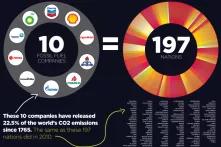
Poland is a major coal producer. Miners there are well organised and have strong political leverage. There is a big question mark over how the new government want to approach EU climate policy. An analysis.
Poland is a member state of the European Union (EU). As such, its negotiating position is aligned with that of the EU. The most recent conclusions of the Council of the European Union (Conclusions) dealing with the Paris Conference of the Parties are therefore a reference point. At this time Poland and the EU’s position talks about the need for Paris to deliver an ambitious and durable legally-binding agreement under the UNFCCC ("the Paris Agreement").
One of Poland’s major preferences when negotiating the Council Conclusions was the introduction of "climate neutrality" into the language – something that showcases Poland’s preferences in climate policy. Placing "climate neutrality" in the Conclusions was one of Poland’s major requests. It is a step away from the commonly used terms "decarbonisation" or "carbon neutrality". Although the first conclusion still uses the words "low-carbon", the implication that coal use will end has been weakened. Poland’s intention can be interpreted in a way that allows for further use of coal, as long as its emissions are offset (for example by planting forests) or when Carbon Capture and Utilization (CCU) technologies are applied through the use of captured CO2 in chemical conversion processes(see Carbon Capture and Utilisation in the green economy; UE ma stanowisko na szczyt klimatyczny. Neutralność węglowa zamiast dekarbonizacji)
Background information
After the Second World War, Poland became a major coal producer. During Poland’s transition to a market economy in the 1990s, the coal mining sector shrank significantly. Economic and environmental factors made it necessary to close many mines and factories. The production of hard coal decreased from 195 million tonnes per year during its peak in the 1980s, to 72.5 million tonnes in 2014. This has caused significant loss of employment, with approximately 300 thousand direct jobs lost since 1989. Currently, it is estimated that the hard coal mining sector directly employs close to 100 thousand people and is responsible for an additional 300 thousand indirect jobs.
The lignite mining sector employs close to 10 thousand people, and 100 thousand indirectly. For geographical reasons (hard coal is mined primarily in Upper Silesia), the industry’s employees are heavily condensed and unionised. This means that miners are well organised and have strong political leverage. Climate policy is seen by the mining sector as a major threat, despite the fact that inefficiency, overemployment and global competition are the direct causes of the sector’s shrinkage. More information on the economics and projections of the Polish hard coal sector, based on analyses conducted by the Warsaw Institute for Economic Studies, can be found in their recent publication "Quo vadis? Prospects for the development of the coal mining sector in Poland (Polski węgiel: quo vadis? Perspektywy rozwoju górnictwa węgla kamiennego w Polsce)".
As Poland has been exploiting coal for so many decades, its energy sector has become very dependent on the resource. Currently approximately 58% of Poland’s gross energy consumption is met by hard coal (44.4%) and lignite (13.1%). The heating and power sectors are also dominated by coal, with it providing approximately 83% of the energy here. On the one hand, this implies that introducing a larger share of renewable energy would have a significant impact on emission reductions: in 2013 emissions from energy industries were responsible for 42% of Poland’s greenhouse gas emissions. On the other hand, the transition towards a more climate-friendly energy sector means the need to reallocate jobs.
From the perspective of the EU-ETS, a highly carbon intensive energy sector also means higher net energy market prices (a €20/EUA price would mean in the current power mix an approximate pressure on market prices of 50%, while on the retail market this is approximately 12%) (Assumptions based on an average market price of electricity on the Polish Power Exchange: 160PLN/MWh, exchange rate: 4PLN=1EUR, and retail price of electricity: 600PLN/MWh). Given that Poland’s energy mix should change over time with the introduction of more renewable energy and energy efficiency measures, this pressure (which is still not very significant when it comes to the end customer) should be relatively small. These changes will be necessary in order to fulfil EU targets (15% RES in gross consumption by 2020) and are already addressed in Poland’s RES action plan. However, from a political point of view, talking about shifting the status quo from a carbon intensive economy towards a low-emission economy appears quite challenging.
It is important to note that although changes are taking place – for example, Poland has tripled its output of renewable power since 2005 – the emission levels of the overall economy are stagnant, at approximately 400 million tonnes per year. Previous significant emission reductions (approximately 29% since 1988 – its Kyoto Protocol base year) stem from the shift towards a market economy, which caused a significant phasing out of economically non-viable (or non-competitive) industry. Since then, Poland has seen heavy decoupling of emissions from GDP growth (by 103%).
In an effort to encourage Poland’s transition to a low-emission economy, the Institute for Sustainable Development and the Warsaw Institute for Economic Studies produced a report in 2012, entitled Low-emission Poland 2050. Within this report, studies showed that in the long-term perspective (up to the year 2050) Poland can benefit from a strong climate policy. Alternatively, the study shows that Poland could be trapped in a middle income country trap – where, without innovation and progress, economic growth would be stemmed.
The Polish government has prepared the first draft of a strategic document, called Narodowy Program Gospodarki Niskoemisyjnej (the National Low-Emission Economy Growth Plan), which also shows growth potential linked to climate action. Although the document has been criticised by the green NGO community for lacking ambition (only a 44% reduction on 1990 levels by 2050 has been shown), this is the first step that the Polish government has taken in long-term planning within the context of emission reductions.
A political overview
Due to heavy pressure from industry, the power lobby and labour unions, Polish politicians have been very reluctant in accepting and implementing EU climate policy. Poland’s treasury owns significant stock in major energy and service companies (mines, railways). Energy companies therefore provide a significant revenue stream for the country’s budget through dividends. Also, 2.5 million Poles are part of a retirement plan (OFE), the investment portfolio of which is made up of approximately 16% hydrocarbon and coal-based energy companies.
This creates a tight knot of implications (which now also includes financial institutions) and a reluctance to implement reforms. Ironically, the strong stance on maintaining the status quo has backfired. Since the coal sector has been confronting significant cash-flow problems, energy companies have been encouraged by politicians to come to their aid. This, along with the slow development of renewable energy technologies in their energy mix portfolios over the years, caused an approximate 30% drop in their market value over the past five months. This is the consequence of a reluctance to change despite adopting EU climate policy (Backloading, 2030 package, Market Stability Reserve).
Polish politicians do not refer to the EU climate policy as an opportunity for change. They have used the EU climate and energy package as a tool for political attacks. Both major political parties (centre-right Civic Platform – PO, and conservative-socialist Law and Justice – PiS) have blamed each other for accepting the 2020 climate package. This was well illustrated during the recent presidential debate, where both candidates accused each other of being pro-climate policy. During the parliamentary elections, most parties (PiS, KorWin, Zjednoczona Lewica, Kukiz) introduced “renegotiation of the climate and energy package” into their programmes. The newly appointed President, Andrzej Duda, was also quoted as saying that the EU climate policy is at odds with Poland’s strategic interests. Going further, Mr. Piotr Naimski, PiS’s energy expert, was recently quoted as saying that failure to agree a binding agreement in Paris would be in Poland’s interest.
It seems, however, that PiS might use different rhetoric when away from Polish soil. During his speech given to the UN general assembly, president Duda claimed that Poland was ready to implement sustainable development goals and play an active role in negotiating a new climate deal. Whether this means that he prefers a strong, binding outcome remains to be seen. Recently, the President vetoed the Doha amendment to the Kyoto Protocol, which was the basis for a second commitment period under the Protocol. His decision was based on the argument that the ratification lacked socio-economic justification. This decision could be seen as a political signal aimed both towards PiS’ electorate (miners’ unions) and at the international community, one that is intended to show a determination to fight off any more ambitious climate policy in future. However, it is important to note that the Presidential Palace will not be playing a decisive role in the UNFCCC process, as it is the job of the government and the Prime Minister to make final decisions. Prime Minister Beata Szydło was also critical of the EU climate and energy package and recently expressed the view that the Paris COP is a challenge that Poland is not ready for.
The PiS election programme stated that the climate and energy package is a problem for power generation in Poland. It is also stated that PiS wants to renegotiate the current climate and energy package, which was signed off by former Prime Minister Tusk. Throughout the election campaign, PiS repeatedly announced that they see coal as the basis of Poland’s power generation in the long term. Since PiS have won the election, we can expect there to be an energy ministry created, which will deal with all energy and climate related issues – from state-owned energy companies, to power regulation and climate policy.
There is a big question mark over how the new government will want to approach EU climate policy. The notion of re-negotiating the climate and energy package climate policy seems to be impossible at this stage, since EU directives have already been established and, for the most part, transposed into Polish legislation. Rolling back implemented legislation and non-compliance would trigger EU sanctions. At a certain point, the Polish government would have to decide between EU membership or compliance with EU law. It seems extremely unlikely that PiS would lobby for Poland to exit the EU, since Poles are generally pro-EU and benefit from EU funds.
Probable major red-line
Poland has a unique status in the UNFCCC negotiation process. Although Poland is part of the "rich world" club of the EU and OECD, under the Convention it is still classified as being in the process of transitioning to a market economy. As such, it is an Annex I country, and not an Annex II country. This Annex I implies that it is a developed country, but has no formal obligation to engage in the financial support of developing countries. It is also a Party to the Kyoto Protocol, though with mitigation commitments. Poland is the world’s 24th largest economy and ranks 72nd in income per capita.
The way in which the UNFCCC divides the world is static. Since 1992 much has changed and Poland is an example of a country which has de-facto moved in the UNFCCC categories. However, this change has not been recognised in the Convention. Some "developing" countries are ahead of Poland and other EU member states (for example, South Korea and Saudi Arabia). It is therefore difficult for politicians in carbon-intensive economies to explain why their country, though less wealthy, is taking action while others lag behind.
This argument has been used intensely throughout the years, and is strengthened by the lack of participation of the US in the Kyoto targets, the lack of binding targets for large emerging economies (such as China or Brazil), and the exit from the Kyoto Protocol of Canada, Japan and Russia (at various stages). This is why it can be expected that a red line will be formed around participation in climate action. Poland will most likely not accept a Paris outcome which does not bind all major emitters (regardless of development status) to concrete emission targets.
Otherwise, it is expected that as long as major objectives are met (which are placed in the Council Conclusions), Poland will not block a Paris deal. Whether the Polish government will want to derail the process for political reasons remains to be seen. Despite President Duda’s recent veto of the Doha amendment, such a scenario remains rather unlikely for the following reasons:
- Poland is an EU member state and the Council has already established its mandate through Council Conclusions;
- The new 2030 climate package binds Poland to new emission reduction targets, which should motivate the government to encourage other international partners to similar commitments;
- Derailing a Paris deal is most probably out of Poland’s reach – this deal is likely to be made between the US, India, Brazil and China, with the European Union acting as a mediator (though it has the potential to be a leader).
- The newly formed government will most probably focus on domestic issues and internal organisation rather than the Paris COP.
You can find more articles on the climate summit in Paris in our dossier.



